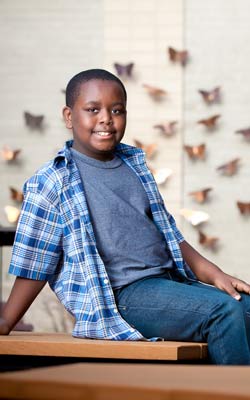 Every day, more than 100 children are treated for scald burns in emergency rooms throughout this country. In many cases, including that of 9-year-old Zechariah Davis, hot liquid from noodle soup prepared in the microwave is the cause of these painfully serious accidents.
Every day, more than 100 children are treated for scald burns in emergency rooms throughout this country. In many cases, including that of 9-year-old Zechariah Davis, hot liquid from noodle soup prepared in the microwave is the cause of these painfully serious accidents.
Hungry from a long day as a fifth grader at Chesterfield Elementary School in Norfolk, Zechariah heated his favorite instant noodle soup in the microwave and set the hot cup of soup on a pillow beside him on the sofa. Before he could take his first sip, the cup tipped, splashing its hot contents down his left leg.
Hearing his screams, Zechariah’s mother, Marian Wilkins, rushed to his side. The skin on her son’s leg and foot was hot and red. Blisters were already beginning to form. Marian immediately cooled the area with wet compresses and wrapped it carefully before packing Zechariah into the car and heading to the emergency department at CHKD.
“Zechariah was in a lot of pain, but I knew CHKD could help,” says Marian. “He is my youngest, and I have trusted CHKD with all my children from day one. They know how to treat kids better than anyone. I just wouldn’t go anywhere else.”
At CHKD, emergency medicine physician Joel Clingenpeel examined Zechariah and suspected that his burns would need debridement, a surgical procedure to remove the dead and damaged skin to improve healing of the remaining healthy tissue. Zechariah was admitted overnight so the hospital staff could prepare him for surgery immediately the next morning.
“Zechariah came to us with partial thickness burns (also known as second degree burns) from his upper thigh down to his ankle and foot,” explains Dr. Robert Kelly, the CHKD pediatric surgeon who would perform Zechariah’s debridement procedure. “Fortunately, his burns did not penetrate the full thickness of his skin, and he did not require admission to the intensive care unit.”
Zechariah chose bubble gum from the 15 flavors of anesthesia offered by CHKD as he prepared for surgery early the next morning. During the procedure, Dr. Kelly removed the burned tissue from the boy’s leg, foot and ankle, creating a neat edge around the wound to minimize scarring, then applied a sterile dressing to reduce the chance of infection. The procedure took less than an hour, and Zechariah was able to go home later in the day with special instructions for follow-up care of his burns as an outpatient.
“At CHKD, we specialize in burn care exclusively for children and are well-equipped to handle burns like Zechariah’s, and even those that are much worse,” says Dr. Kelly. “Burns can be extremely painful injuries, and our ability to help children manage pain is especially strong. It’s important to keep our patients as comfortable as possible.”
Marian never expected Zechariah’s burns would need anything more than ointment and bandages, and the news that he would require surgery was frightening. But she knew she’d come to the right place.
“Dr. Kelly walked me through everything they were going to do in surgery and explained how long it would take,” says Marian. “It’s always like that at CHKD. The doctors and staff constantly take the time to make sure that my kids and I understand what is happening, step by step. It makes such a difference, and I am so grateful for that.”
Through this experience, Marian also learned that what happened to Zechariah is not unique. At CHKD and emergency departments around the country, prepackaged noodle soups are a frequent cause of scald burns in children.
EVMS surgical resident Dr. Leah Sieren conducted a research project at CHKD in 2010 in which she examined records of patients who had suffered traumatic injuries over the previous 10 years. She found that burn injuries to children between ages 0 and 14 had increased by more than 600 percent while other traumas had decreased or leveled off. In children ages 0 to 9, scald burns from hot liquids were the most frequent – and noodle soup products had become a common culprit.
The design of many noodle soup containers – a tall cup that is wider at the top than the bottom – can cause them to tip over easily. The noodles also retain more heat than liquid alone and can stick to the skin when spilled, causing more severe burns.
Dr. Clingenpeel, the emergency department doctor who initially saw Zechariah, says the number of scald incidents can be reduced if families learn about the dangers. “Most families are aware of the dangers of hot water from the tub or faucet, but non-tap water scald burns now far outnumber tap water scalds in young children,” he says. “Parents should treat all hot things as if they are as dangerous as fire. Hot foods and liquids should be kept out of reach of younger children, and older children should understand the risks of holding, carrying or transferring these items.”
While parents take comfort in knowing that CHKD’s emergency department and surgeons are always nearby and easy to access, few experience how quickly life changes for their child in an instant. “This was a tough experience for Zechariah, and for me to watch him go through it,” Marian says. “We were blessed with great care at CHKD. He has recovered completely with scars that are barely visible, and we hope by letting people know our story, other children won’t have to go through this at all.”
Dr. Kelly practices with CHKD Surgical Group’s pediatric surgery practice. Dr. Clingenpeel practices with Children’s Specialty Group, PLLC, at CHKD.